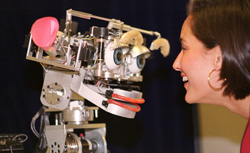Cynthia Breazeal, Director of the Personal Robots Group at the MIT Media Lab
Building robots that understand human emotions and make people healthier.
For most of us, the closest we get to a robot in daily life is a Roomba. But Dr. Cynthia Breazeal, director of the Personal Robots Group at the MIT Media Lab, wants to change that. "I haven't given up that dream of the robot sidekick," she told the crowd at the 2008 Singularity Summit.
The 43-year-old Breazeal—who, like many of her generation, grew up addicted to Star Wars and Isaac Asimov—became interested in space robotics as an undergraduate, hoping it would bring her closer to her dream of becoming an astronaut. But as a grad student at MIT in the early 1990s, her interests shifted from the cosmos to terra firma. Her new goal: to create robots that could interact with people, not just do their bidding.
Breazeal's pioneering work has changed our expectations of what robots can and should do. One of her most famous projects is Kismet, a body-less, language-less machine with wide eyes and kissy lips that can display emotions while interacting with humans. (Watch Kismet look chagrined after a scolding.) She also worked with expert puppeteers on a cuddly robot named Leonardo who can pick up on nonverbal cues. Breazeal likens these "social robots" to pets—empathetic-seeming creatures who can prompt their owners to let down their guard.
Much of Breazeal's focus today is on building robots that can improve the quality of life for the chronically ill, the elderly, and the very young. Autom, a friendly weight-loss coach created out of her Personal Robots Group, could bring "concierge-quality care" to the masses, she argues. In a recent study, participants spent far more time with Autom than with a touch-screen computer program that gave identical advice. (Some even dressed up and named their robots.)
Breazeal, a mother of three young boys, is also excited about using her creations for early-childhood education. One project, Playtime Computing, blends a virtual fantasy world with a physical "Alphabot" that allows kids to take part in entertainment instead of just sitting there passively watching a TV show. Playtime Computing hasn't made its way to elementary schools quite yet, but it could play an important role in teaching children language skills, as well as creating new opportunities for distance learning. And it's certainly more practical than a robot that can dance.
Read a Q&A with Cynthia Breazeal.
Watch Breazeal's recent TED talk and see videos of her robots in action.
Check out the rest of our technology Top Right:
Jeff Bezos, founder and CEO of Amazon.com.
David Ferrucci, lead researcher for IBM's Watson project.
Salman Khan, founder of Khan Academy.
Brian Tucker, president of GeoHazards International.


